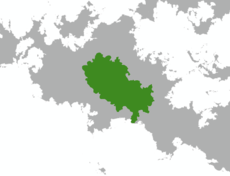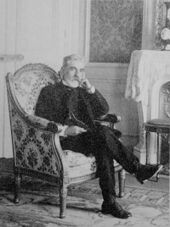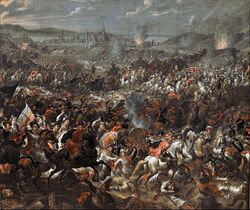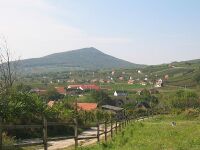Lusavan
| Historical land | |||
| |||
 The Kingdom of Lusavan under Ruben XIX in 7050 | |||
| Languages | Lusavanic, Tavonian, Heyelrem dialects, Anisoran, Parnethian | ||
| Religion | Izha (minority Orkanan) | ||
| Demonym | Lusavan/Lusavanic | ||
| Capital | Tenavelan (of East Lusavan) Karmon (of Tavonia) | ||
| Government | Kingdom (5946-7391) Grand Principality (7375-7616) Republic (7616-present) | ||
| |||
Historical events
| |||
| Preceded by: | |||
| Today part of: | |||
- This article is about the historic region of Lusavan. For other uses, see Lusavan (disambiguation).
Lusavan or Lusava (Lusavanic: Լուսևան; Lusavan; Parnethian: Λυσσαβία; Lussavia; Pastanan: Lusavium) is a geopolitical, cultural and historical region and former kingdom in Anaria Minor. In a historical context, Lusavan refers to the lands ruled by the Kings of Lusavan, and therefore largely conforms to the historic borders of the Kingdom of Lusavan. However, in a broader cultural sense it can also refer to all lands currently and historically inhabited by the Lusavanic people, or those lands in which Lusavanic is or was spoken. Today, Lusavan remains divided between various states, with East Lusavan and Tavonia claiming the mantle of modern Lusavanic states.
While specific geographic definitions of Lusavan remain varied, Lusavan is a region centred in the Makur Valley, particularly the south side of the River Makur in central Anaria Minor. Bound in the west by the Greater Bhazen and Garda Mountains, in the south by the Levan Mountains, and in the east by the Matrignanese hills, Lusavan occupies much of central Anaria Minor. The two largest lakes in Anaria, Lake Karamon and Lake Parrona, are situated in the historic Lusavan region, although today they mark the northern border with Anisoran speaking majorities. Lusavan is renowned for its natural beauty, its mountains and the lush Makur river valley.
The historic land of Lusavan emerged as a collection of feudal territories in the late 5th millennium before being conquered by the Parnethian Empire under Vissarion Nikitis in the 5300s. Forming a core region of the Empire for many centuries due to its commercial and strategic position along the Makur Valley, the collapse of Parnethia in 5865 led to the establishment of the Kingdom of Lusavan in 5946 under Karen I. Converting to Izha in the 6300s, the Kingdom became a major battle ground between the Izhaic west and the Orkanan east during the 7th millenium. The Great Holy War (6810-6843) was a defining moment in the religious struggles and resulted in Izhaic forces pushing east, securing Lusavan as an Izhaic kingdom. Emerging Anisoran nationalism would bring Lusavanic control over eastern Anaria Minor to an end, with the Anisoro-Lusavanic War (7372-7375) precipitating the eventual abolishment of the Izhaic Kingdom of Lusavan in 7391 and the establishment of the Grand Principality of Lusava, remnants of which remain part of Anisora today.
Following centuries of control by Orkanan Anisorans, Lusavanic nationalism remains an enduring and increasingly potent force in Lusavan since the collapse of the Anisoran Empire in 7616. Ethno-religious tensions remain common throughout Lusavan, with sectarian violence common. After the Pan-Anarian War, answering pressures for an independent Lusavanic state, Anisora granted initial independence to Tavonia and later after the Wolgos Scourge similarly granted independence to East Lusavan. However, the controversial Treaty of Makaros precluded the establishment of a united Lusavanic state. The ethno-religious Pan-Lusavism ideology that strives for a united and fully independent Lusavan remains a potent force today.
Etymology
The name Lusavan (Լուսևան) came to describe the Lusavanic people of central Anaria Minor, and the lands in which they lived, as early as the 5th millennium. Coming from the Old Lusavanic root word լուսաւոր (lusawor), meaning star, or more figuratively prophet or bringer of light, as well as the adjectival forms meaning luminous or bright, the region has long been associated with stars and light. The root survives with the same meaning into modern Lusavanic as the adjective լուսավոր (lusavor).
The Old Lusavanic epic poem Struggle of the Stars (Old Lusavanic: կռիւ լուսաւորաց; Kṙiw Lusaworacʿ)1 is generally agreed to have had a major influence on the origins of the name and the traditional assimilation between the Lusavanic people and the stars, with some scholars, most notably the famed Lusavanic scholar R. Hayk Petrosyan, arguing that the epic directly inspired the people to begin calling themselves the “People of the Stars”, or "Luminaries" – Petrosyan's favoured translation (Pastanan: Illustres).a
History
Anisoro-Lusavanic war
After the formation of the Anisoran Empire in 7365, the new state began to look outwards and set in motion a period of expansionism across Anaria Minor. The war of conquest waged by the Anisoran Empire over the Kingdom of Lusavan was ostensibly started to 'liberate' Anisoran speaking and other Orkanans living under Lusavanic rule, principally in Parrona and Vasharat (Vascano). Although emerging Anisoran nationalism and increasing religious tensions undoubtedly played a part in the desire to go to war, most historians and commentators at the time suspected more cynical motives behind the designs of the Anisoran Emperor Marius I. Well known for his ruthless ambition and military credentials, Marius' imperial project was well articulated by the new regime.
War with the Kingdom of Lusavan along with the Kingdom of Becuvitatia had long been a goal of the new Anisoran regime. Together, the two kingdoms represented the most immediate threat to Anisoran hegemony over eastern Anaria Minor. As such, the Anisoran prime minister at the time, the Duke of Giullana, famously described the war as a 'political necessity'. According to the Anisoran military historian R. Livio di Porghiano, 'war against Lusavan was not only necessary but inevitable'. The legitimacy of both Marius as emperor and the entire Anisoran imperial project rested on the liberation of all Anisorans and the expansion of imperial protection to all Orkanan people of Anaria Minor (in what would later be formalised under the Holy Shrines Covenant). With the Empire barely five years old, the invasion of Lusavan presented the emperor with the perfect opportunity to prove the ambition of the Anisoran project to both his own people and the international community.
The war against Lusavan widened to a much larger regional conflict with the intervention of the Kingdom of Becuvitatia in 7373, although this only delayed the victory of the superior Anisoran forces. In the aftermath of the Anisoran victory at the battle of Andravan (7375), the Lusavanic King Aram III, together with his Becuvitatian ally Domnitor Nicolae, were forced to concede to harsh terms dictated by the Anisorans in the Treaty of Loraveno (7375). The treaty diminished the kingdom of Lusavan to a shell of its former self, annexing the vast majority of the kingdom's lands. The Anisorans divided the annexed territories between the newly established Principality of Parrona and the Grand Principality of Lusava, which Marius I would rule over personally. Aram III was to abdicate in favour of his young nephew Ruben XXIII, who effectively became a puppet of the Anisoran emperor. The Anisora-Lusavanic war was the principal step which confirmed Anisora's hegemony of eastern Anaria Minor, but marked the effective end of a united Lusavan.
Lusavanic nationalism under Anisoran rule
Following the annexation of Lusavan and the creation of the Grand Principality in 7375, the Lusavanic population still had a strong sense of national identity. As a distinct ethnic group defined mostly by speaking the Lusavanic language and adherence to the Norynan sect of Izha, the Lusavanic people have a strong tradition of nationalism. Although nationalist sentiment has always been present, for much of the 75th century calls for national recognition and independence were actively suppressed by the Anisoran imperial government, and the government of the Grand Principality itself. Anisoran oppression, as well as religiously motivated atrocities against the Izhaic population of Lusava, fuelled nationalist anger which precipitated agitation, strikes, and terrorist attacks across Lusava.
The repressive and anti-Izhaic policies of the Anisoran prime minister the Count of Andagna during the 7460s and 7470s, in particular, contributed to Lusavanic nationalist uprisings during the Revolutions of 7473. The largest uprising during the Revolutions was led by the Lusavanic nationalist Vardan Gevorgyan. This religio-nationalist uprising against Anisoran rule, the so-called 'Gevorgyan Revolt', called for independence and the end of religious persecution against Izhaics, and is still remembered in Lusava today, with many nationalists considering Gevorgyan a national hero and martyr. After the Revolution was put down, reforms were introduced that granted Lusava a constitution, considerable autonomy within the Empire, and protections for the Izhaic population, but this only went so far in placating entrenched Lusavanic nationhood and nationalist agitation.
Following the Gevorgyan Revolt, nationalist sentiment was mostly expressed through protests and parliamentary politics. The Lusavan National Party (LAK) (Lusavanic: Լուսևանյան Ազգային կուսակցություն; Lusavan Azgayin Kusakts’ut’yun) remained the largest nationalist party in Anisoran-controlled Lusava, and remained one of the two largest parties in the National Parliament. The Party actively called for independence from the Anisoran Empire. The LAK remains controversial, however, as they have been suspected of supporting terrorist activity during this time, including most famously an attack on a Moreva Petroleum Corporation oilfield in 7577, which resulted in numerous deaths. The Party was banned from standing in the Anisoran federal elections, meaning they could not field candidates for election to the Anisoran Chamber of Deputies.
Meanwhile, the Lusavan League (LL) remained the largest political party in Lusava during the 75th and 76th centuries, which did stand in federal elections. It stood as a more moderate party, supporting certain nationalist policies nevertheless. These policies included civilian oversight of the Lusavanic military,2 further protections for the Izhaic faith, and Lusavanic state control of oil reserves, among other policies. The LL normally received the vast majority of votes of Lusavans during federal elections in the run-up to independence, and remained a significant block in the Chamber of Deputies as the most dominant and powerful Lusavanic voice in the Anisoran imperial parliament.
Pan-Anarian War
Nationalist sentiment increased during the Pan-Anarian War, particularly during the the 7510s and 7520s when Emperor Flavian's military unitarian government severely restricted freedoms and suspended the constitution for an extended period of time. Nationalist leaders during that time rallied under hatred for the Anisoran emperor, who was also their head of state as Grand Prince of Lusava, and called for agitation against the war effort. This polarised opinion within Lusava, with many more moderate nationalists claiming that fighting the War was necessary for upholding Lusavanic national pride and ensuring her lands were not overrun. The oil fields in the north of Lusava were a major target for Tahani and United League forces for much of the War. Some nationalists at the time, however, encouraged the advance of the Tahani armies to liberate them from Anisoran tyranny. As fellow Izhaics, many ultra-nationalists, such as Nayek Verdyan, saw the Tahani as natural allies against the Orkanan Anisorans. However, these calls were condemned in a vicious but highly successful propaganda campaign orchestrated by the Anisoran government, which portrayed the Tahani as savages, and highlighted the key differences between the Norynan Izhaic sect the vast majority of Lusavans followed, and the more orthodox Kökenleri sect followed by many Tahani.

Tavonian independence
- Main article: Tavonia § Protectorate of the Anisoran Empire
By the end of the Pan-Anarian War in 7552, there were clear and unambiguous calls for an independent Izhaic Lusavanic state. With sectarian and nationalist violence and mutinies rocking Anisora after peace was declared, the Anisoran government granted independence to what became the Principality of Tavonia, in western Lusavan at the terminus of the Makur Valley. According to the terms of the Treaty of Asola, Tavonia remained a protectorate of the Anisoran Empire, with Pena controlling the state's foreign policy, while all internal affairs are governed by Karmon. However, it wasn't until the end of the Anisoran Civil War in 7616 and the granting of independence to neighbouring East Lusavan that precipitated the true independence of Tavonia. The Tavonian Revolution in 7617 resulted in the abdication of Prince Aram II and the proclamation of the modern Republic of Tavonia.
East Lusavan independence
Culture
- Main article: Lusavanic culture
Religion

Lusavan has had a very rich, and very bloody, religious history. Situated in central Anaria Minor between the Izhaic west and the Orkanan east, over the last millennium Lusavan has been a principle battleground between these two religions. With the proselytising Izhaic sects of Tharna spreading Izha to Anaria Minor in the early 7th millennium, largely removing Sadarisnism from the region, the Peratolian Orkanan congregations to the east radicalised in response. As a consequence a series of religiously motivated conflicts, wars, and atrocities soaked the Lusavanic lands in blood, with mass conversions, religious oppression, and religio-ethnic displacements common throughout the region's history.
Through a mixture of proselytising, forced conversions and resettlements, large swathes of Lusavan converted to Izha in the 6200s, with the Kingdom of Lusavan formally converting to the emerging Norynan Izhaic sect in the early 6300s. It has been the majority religion of the region since, although sizeable minorities of Orkanans and even some Sadarenes remain throughout Lusavan today.
Religious tensions remain prevalent in the region today, with sectarian violence commonplace, particularly between followers of the Alí̱theia Izhaic sect and Peratolian Orkanans. While large scale religious pogroms and mass atrocities have not been seen in the region for many decades, tensions remain high throughout Lusavan, with religiously motivated violence frequent occurrences. The linkage between Lusavanic ultra-nationalism and Izha is well entrenched, resulting in little distinction being drawn by many anti-Anisoran terrorist and agitation groups between nationalist and religious goals. Numerous terrorist attacks have been committed within and from Lusavan, targeting Anisoran officials and Orkanan religious figures.
Lusavan today has a sizeable Orkanan minority, with isolated communities of varying sizes and denominations dotted throughout the region due to myriad historic and legal reasons. Due to Anisora's historic involvement in the region, and the numerous religiously fuelled wars waged in Lusavan, the Emperor of the Anisorans, as the religious leader of the Peratolian Orkanan congregations, has claimed various rights and responsibilities in Anaria Minor, including Lusavan; claims that the Regent of Anisora has in recent decades assumed. The Holy Shrines Covenant is the legal and moral framework by which the Emperor of the Anisorans (and now Regent) acts as the protector of the sacred Orkanan shrines, and by extention Orkanan followers, under Izhaic rule. A controversial declaration, many Izhaics maintain that the Covenant has been used as an excuse to intervene in Lusavan to further the Anisoran neo-imperialist agenda, while Orkanans maintain it is a vital safeguard against religious persecution by the Izhaic majority.
Pan-Lusavism
Pan-Lusavism is an ethno-religious and nationalist ideology and political movement that seeks to promote and further the creation of a fully independent and united Lusavanic state. With strong religious Izhaic roots, the ideology and movement considers an Izhaic Lusavan to be a coherent and indivisible entity, but international treaties including Asola (7552) and Marakos (7616) have prevented this from being realised. Pan-Lusavists have been heavily involved in numerous terrorist actions and anti-Anisoran and anti-Orkanan agitation movements across Anaria Minor, with promotion and furtherance of sectarian violence common among the ultra-nationalist wing of the movement.
The independence of East Lusavan and Tavonia as separate states has led a great many Lusavanic nationalists to decry the creation of the Tavonian state in 7552 and the failure to unify after 7616 and the Tavonian Revolution in 7617. Many Pan-Lusavists consider Anisoran moves to veto the formation of a united Lusavan as a cynical ploy to create division between the Lusavanic people and prevent the resurrection of a united Lusavan.
Political nationalism in Tavonia and East Lusavan today is largely separated into two forms. The first, exemplified by the ruling National Unity Party (Ազգային Միաբանություն; Azgayin Miabanutyun) in Tavonia, is a Pan-Lusavanic ideology with strong conservative Izhaic values. The second, exemplified by the Congress of Tavonia Party (Կոնգրես Տավարատի; Congres Tavarati), and is a largely socialist nationalism that seeks to cultivate a 'Tavonian' nationalism, where Tavonian citizens, regardless of ethnicity, language or religion, can find common cause. This attempt to cross the ethnic, religious and linguistic divides of the country remains abhorrent to the Pan-Lusavists and ultra-nationalists that demand a united, Izhaic Lusavan.
Geography
The geography of Lusavan is dominated by the Makur Valley, following the mighty Makur River that runs through the heart of Anaria Minor. The river and surrounding plains are fertile and support a wide range of agriculture and viticulture, while the western regions of Lusavan at the terminus of the Makur Valley have a more varied soil quality, with cattle and livestock grazing common. The two largest lakes in Anaria, Lake Karamon and Lake Parrona, are located in the central-north of Lusavan along the Makur Valley, and joining as they do the Makur River provide an easily navigable waterway connecting the mountainous interior of the subcontinent in the west to the Medio Sea in the east.
The traditional borders of Lusavan are demarcated in the west and south by the Bhazen Mountains, with the Greater Bhazen Mountains, the tallest mountain range in Anaria Minor, to the west, the North Bhazen Mountains to the north-west, and the Levan Mountains to the south. The northern and eastern borders of Lusavan are less well defined and due to the large open plains that largely define that region's geography, have changed hands numerous times over the centuries. Much of the open land north of the Lakes has historically been included in the Lusavan region, but is today largely occupied by Anisorans and included in modern Anisora.
Being surrounded by the Bhazen Mountains on at least two sides, Lusavan is well known for its mountains and hills. The tallest mountain in Anaria Minor, Mount Andorus (6,832 m; 22,414 ft) is partly located in Tavonia, with the eastern col falling within the extreme-western border of Lusavan in the Greater Bhazen Mountains. Due to this mountain range, much of western Lusavan is isolated. Much of the mountainous regions of Lusavan, including the extensive foothills that dominate much of the country, are covered in forest, supporting a rich diversity of wildlife.
-
The Aparan Hills in the Aparan region of southern Lusavan.
-
The Makur River runs through the centre of Lusavan.
-
Mount Andorus is the tallest mountain in Anaria Minor.
-
The Andarat region in eastern Tavonia is known for its viticulture and vineyards.
See also
Notes
1 Today only fragments of the original epic survive. Scholars have estimated that the epic in full would have contained over 9,000 lines, with only 2,778 surviving today, mostly through citation by other ancient authors (most notably Pastanan chroniclers), as well as a small number of inscriptions found in recent archaeological digs in and around the ancient capital of Tanavan. For further detail, R. Hayk Petrosyan's 7510 commentary (in Pastanan) is considered the most comprehensive scholarly work on the Epic.a
2 According to the Constitution of the Grand Principality of Lusava and Vascano, the Grand Prince was commander-in-chief of the military. During the Pan-Anarian War major efforts to integrate the armies of the Anisoran Empire resulted in significantly reduced direct Lusavanic influence and control over her armies.
References
a Petrosyan, R.H. (7510) Commentarius: Certamen Stellarum, Tenalevan. (Hallish: The Struggle of the Stars: A Commentary); also available in Lusavanic with Armen Mirak's acclaimed 7573 translation.




